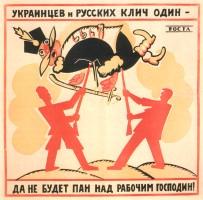
1920, Vladimir Maiakovskii, Ukrainians and Russians have a common cry .., Part of a ROSTA window
I met the Faldins for the first time at the end of March 1994 in St. Petersburg, having received their address from Martha Sylvestrova, an invaluable source of information and connections in Eastern Europe. My daughter Verena and I had taken the night train from Moscow to Leningrad, as some people still called the city then. Our russian friends had bought the tickets for us, because they were much more expensive for foreign tourists. Verena, who had little to fear as she speaks russian fluently, told me to shut up for the duration of the trip as not to give us away. I tried. The same surcharges still apply today for museum or theater tickets, but nowadays the local guards are much more experienced in spotting foreigners, and probably also less tolerant.
It was still cold, the river Neva was frozen and piles of snow lay in the streets, so Faldin suggested on
the telephone that we
meet at 10 o'clock inside the comfortably warm Maiakovskii metro station. It is the only metro station I know with
sliding doors to keep the passengers away from the tracks until the trains have arrived, and although it is
beautifully decorated with bright red tiles, the unusual construction always reminds me of Maiakovskii's suicide,
in 1930. Faldin told us later of his admiration for this great russian poet and artist, and poster designer.

1983, Viktor Kundyshev, Leningrad - Petrograd
He wanted to introduce us to some of his friends, and so we took a "taxi", which meant that he stopped
the first car he saw on the street, offered him some money, we jumped in and did not quite get where
we wanted, but close, and after a second hike arrived at Viktor Kundyshev's studio without any problem.
Faldin had told us that life was very difficult for his friend, who, in his sixties, had trouble adjusting
to the brave new world, and had not received any poster commissions since the fall of the state powers that
looked after graphic designers during communist times. Nevertheless, we were greeted with a cordial welcome,
asked to sit down and have a little sip of vodka before we started to talk about business, and so we soon toasted
to friendship, to peace, to posters, to Viktor and to Alexander, and to Rene and his beautiful daughter.
"Watch out", she managed to whisper into my ear
between two gulps, "this is an old russian trick, they know very well that a happy customer is much easier
to deal with than a thirsty one". My recollections are a bit hazy as to what happened next, except that I was
shown a collection of exquisite works, and left the studio happy indeed, clutching a roll of posters in my arms. Looking at them
later at home, I was so proud of my new Kundyshevs that I included one of them in my very
first web exhibition.
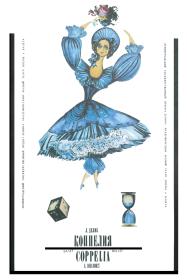
1973, Olga Biantovskaia, Coppelia
Our next stop was Olga Biantovskaia whom I had known from her internationally famous posters for the theater, and especially the ballet. There was much more order and discipline in her studio than in Viktor's, and despite it's austerity she transformed it with two cookies, a cup of tea, and her charisma into an elegant salon, and addressed me as "Gospodin Rene", a greeting usually reserved for distinguished nobility. Olga herself looked like a prima donna, having completely absorbed the world of theater and ballet in which she lived and worked. The walls of her studio were covered with polish posters and she was flattered when I mistakenly took one of her posters (Coppelia, 1975) for an early work of Henryk Tomaszewski.
We continued our trip through downtown St. Petersburg, and Faldin commented what we saw. The streets were lined with elderly women, obviously very poor, standing in the cold trying to sell what they could spare, worn clothes, food, wrenches, soap, kittens, shoes. The economic situation in the city is disastrous, and in the tight grip of the Mafia, in all details. Even these poor women would not be allowed to stand where they are without the Mafia's consent. I have bought a computer recently, through a friend so as to hide all traces of the deal from the Mafia who would otherwise surely come to the conclusion that somebody rich enough to own a computer could also afford to pay for their "protection".
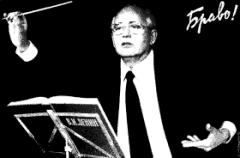
1987, Alexander and Svetlana Faldin, Bravo!
Faldin's own studio was on the top floor of an old building, and the door was heavily protected with iron bars,
steel plates, multiple locks and padlocks, like most doors I saw in Russia. But before getting to the door, we
had to clear away large pieces of cardboard that were littering the stairways, the bed of homeless people that
are sometimes spending the night here. The studio itself had again a completely different character than the
two we had seen before, more in active use, like a factory, with all kinds of photographic equipment standing
around, paintings on the wall, large sheets of black paper, it was getting dark, but I finally saw the very posters
that I had only known as reproductions in catalogues and books so far, the soviet Christmas tree with the
red star, the Bravo!, the Komsomol, quite an experience for me. I also learned there were strict, although
unwritten rules about the use of the colors red and black in depicting soviet rulers. To show Gorbachev all in black
for example put him on the same level as the imperialist aggressors in the agitprop posters and was an offense that,
in 1987, clearly irritated the authorities.
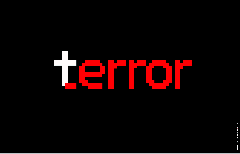
2001, Alexandra and Anastasia Faldin, Terror
It was now 4 o'clock in the afternoon, and Faldin mentioned that there was something to eat at his apartment, but before we could maybe have a quick visit to the studio of Vladimir Dulov, another friend. Like Federico Fellini, Faldin is always very busy, always has one more idea to try out, and is therefore always late, and certainly was on that day, but when we arrived at his place, his family - Svetlana, the daughters Alexandra and Anastasia (who were to become graphic designers also) and Alexander's mother - miraculously had just sat down at the table as if 4 o'clock was quite a normal time for lunch.
I will never forget the sight: The round table was covered with all kinds of delicious food, there was barely a place left for a spoon. I regret not taking notes, but quoting from memory there were potatoes, meat, chicken, cucumbers, mushroom soup with smetana (a special white cream that is used extensively in russian cuisine), cottage cheese, cream cheese, tomatoes, black current marmalade, herbal tea with honey, red wine, champagne, cognac, and vodka flavored with red roots. While I was enjoying the meal, my daughter, a chemistry student at that time, had a lively conversation in russian with Mrs. Faldina, a physics teacher. She later confided to me that it had been more like a tough exam for her, and she was impressed by the depth of our hosts knowledge.
When we walked back to the train station, Alexander told me how he had started to make the first of the critical posters, that later became know as "Perestroika posters", and the early history of that movement :
The first new, unexpected, unusual posters appeared in Leningrad at the exhibition "Aphorism" in 1983.
It was initiated by Georgii Razkov, then chairman of the poster section of the Union of Artists
in St. Petersburg. The next exhibition, in 1985, caused a scandal: some posters had to be removed.
The exhibition of Leningrad posters in 1987 became a sensation in the whole country, it can be considered as
the beginning of "Perestroika posters". There were very long queues of people who wanted to see it
and it was shown afterwards in other cities of the USSR and in Moscow too.
In 1988, Martha Sylvestrova brought it to Brno, in Czechoslovakia.
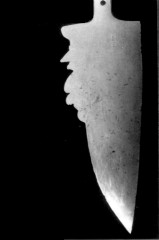
1988, Krzysztof Ducki, Wojczenko, Andrei Sheliutto, Vladimir Tsesler, Stalin
After this event or approximately at the same time, some sharp works appeared in the so-called "creative country cottage" (tvorcheskaya dacha) in Riga . Such workshops were organized in different parts of the country, for example at the Black Sea, or in a place not far from Moscow, at Lake Baikal, in Riga and so on, for members of the Union of Artists, painters, sculptors, ceramics artists, poster designers and others from all over Eastern Europe, from Tashkent to Kiev to Tallinn. They had a free appartement and full board and lodging for two months, an opportunity to work, meet each other, to communicate, discuss their ideas and works.
Before 1990, poster designers enjoyed a relatively high position in the cultural hierarchy, probably going back to Lenin's ideas on the importance of "propaganda". To pamper the opinion leaders and foster "unity of doctrine" in so-called workshops in plush locations is standard practice in any global company, but it is ironic that they played such an important role in the development of Perestroika posters.
I first heard about these Riga workshops from the polish designer Krzysztof Ducki who lives in Budapest, and
who attended one in 1987, a year before Faldin went there. When I visited Ducki in 1988, I was surprised
how he dared to treat subjects in his posters that I thought would be off limits in Hungary, like the crimes of Stalin,
or the hungarian uprising of 1968. Apparently he too, like Faldin, brought back some ideas or some encouragement from Riga.
At that time, I had not the slightest clue of the revolution that was to sweep over Europe only two years later.
I thought that "Perestroika" was a sort of soviet version of Mao's trick to "let a thousand flowers bloom", in
other words, a ruse based on an empty promise of freedom of expression to find out who was foolish enough to use
it, so he could be punished later. Ducki was not allowed to show the posters in Budapest,
but at least had an exhibition in the province. I admired his courage but was sure that he was stepping into a trap.
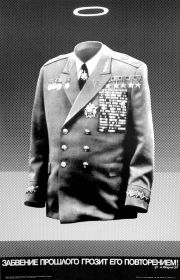
1987, Alexander Faldin , (Brezhnev's dress uniform)
Meanwhile, in Russia, the situation was worse, and more dangerous; to show a pair of bluejeans in a poster was enough to accuse it's author of counterrevolutionary activity. Faldin told me that when he made the poster with Brezhnev's empty uniform in 1987, there were discussions within the family whether he should show it publicly or not, and they found it too risky for his career as graphic designer, and also too risky for his life, as he had received threats before that if he did not stop making these kind of posters then maybe he could soon be involved in a "traffic accident", i.e. run over by a truck. His mother cried when he went ahead anyway, in a mood like Martin Luther's "I can do nothing else, here I stand, so help me God!".
Alexander Faldin was one of the first to speak out in strong visual language against the communist regime, and if one person is singled out for inventing "Perestroika posters" that credit should go to him. Many others jumped the bandwagon years later when it was entirely safe to do so.
This lesson in poster history, taught during a short walk in a cold night, has been one of the most moving moments in my life as poster collector. When we arrived at the train station, Galina Tereshonok, another of Alexander's designer friends appeared out of the dark, handed me another roll of posters, and we boarded the train back to Moscow. From there, Verena carried the rich and heavy bounty back to Switzerland and I continued my trip to India to collect more and very different posters, but this is another story ..